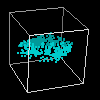
Astronomy and Astrophysics
Links
Home
Links
Glossary
Monday
Tuesday
Wednesday
Thursday
Friday
Create Report
Orbits
Why doesn't the Earth fall into the Sun?
Ask anyone why the Earth orbits the sun, and they will tell you, "gravity". However, what does gravity do to a dropped ball on Earth? It falls down.
Imagine a ball tossed in an arc. The ball travels both in the horizontal direction and in the vertical direction. With the Earth and the Sun, the Earth is constantly "falling" in the same manner, but it just overshoots the Sun, and falls around it instead of towards it.
This is because the Earth has some horizonatl motion. If the Earth were just sitting still, gravity would pull it straight towards the Sun, and things would get real real hot!

Using GalaxSee, create a model of the Earth and the Sun.
- Go to Galaxy->Scale and select "Earth-Sun".
- Go to Galaxy->Model Settings and select
- Time Step = 1 day
- Sheild Radius = 100 mAU
- Dark Matter = 0
- Method = Improved Euler
- Go to Galaxy->Galaxy Setup and select 2 stars. The rest doesn't matter, we are going to change it anyway.
- Use Galaxy->New Galaxy to create your new model.
- Use the Galaxy->Show List feature to enable the star list.
- Edit the first object. Give it the mass of the sun in Earth Masses. You may need to look this value up. Give it the proper value for the position and velocity in the x, y, and z directions.
- Edit the second object. Give it the proper value for the mass of the Earth in Earth masses. Place it along the x axis at the same distance the Earth is from the Sun, in AUs. (Hint, 1 AU is defined as the distance from the Earth to the Sun).
- Make a guess as to how fast the Earth is moving around the sun. A good first assumption would be that the Earth is moving entirely in the z direction. Try an initial velocity of 1 AU per day.
- Save the model (trust me).
- Describe what you think will happen when you run the model.
- Run the model.
- Describe what did happen? Can you explain this?
- Try the same thing for an initial velocity of 0. What do you think will happen? Run it. What did happen?
- See if you can find out what velocity is required in our model to have the Earth go in a circular orbit around the Sun.
- Is there an observation to which you can compare your model result?